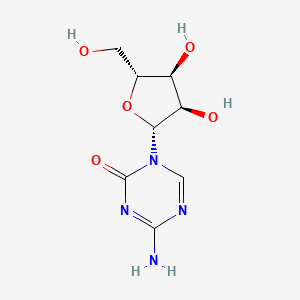Drug Information
Drug (ID: DG00860) and It's Reported Resistant Information
| Name |
Azacitidine
|
||||
|---|---|---|---|---|---|
| Synonyms |
5-azacytidine; Azacitidine; 320-67-2; Ladakamycin; Azacytidine; Vidaza; Mylosar; 5-azacitidine; Azacitidinum; Azacitidina; Azacitidinum [INN-Latin]; 5-AZAC; Azacitidina [INN-Spanish]; NSC-102816; C8H12N4O5; NSC 102816; U-18496; 4-Amino-1-beta-D-ribofuranosyl-s-triazin-2(1H)-one; UNII-M801H13NRU; NSC102816; 5AzaC; 4-Amino-1-beta-d-ribofuranosyl-1,3,5-triazin-2(1H)-one; Antibiotic U 18496; CHEBI:2038; M801H13NRU; 4-amino-1-((2R,3R,4S,5R)-3,4-dihydroxy-5-(hydroxymethyl)tetrahydrofuran-2-yl)-1,3,5-triazin-2(1H)-one; 4-Amino-1-(beta-D-ribofuranosyl)-1,3,5-triazin-2(1H)-one; MFCD00006539; 4-amino-1-[(2R,3R,4S,5R)-3,4-dihydroxy-5-(hydroxymethyl)oxolan-2-yl]-1,3,5-triazin-2-one; 4-amino-1-[(2R,3R,4S,5R)-3,4-dihydroxy-5-(hydroxymethyl)oxolan-2-yl]-1,2-dihydro-1,3,5-triazin-2-one; WR-183027; NCGC00090851-04; DSSTox_CID_116; U 18496; DSSTox_RID_75378; DSSTox_GSID_20116; U-18,496; CCRIS 60; SMR000857239; Vidaza (TN); HSDB 6879; 5-aza-CR; SR-01000075662; EINECS 206-280-2; BRN 0620461; Onureg; Azacitidine (JAN/USAN/INN); Azacitidine [USAN:INN:BAN]; 4-Amino-1-beta-D-ribofuranosyl-1,3,5-traizin-2(1H)-one; NS-17; 4-amino-1-[(2R,3R,4S,5R)-3,4-dihydroxy-5-(hydroxymethyl)tetrahydrofuran-2-yl]-1,3,5-triazin-2-one; CAS-320-67-2; Azacitidine (Vidaza); 2-(beta-D-Ribofuranosyl)-4-amino-1,3,5-triazin-2-one; Antibiotic U18496; U18496; Spectrum_001262; 4-Amino-1-beta-D-ribofuranosyl-1,3,5-triazine-2(1H)-one; Spectrum2_000786; Spectrum3_001509; Spectrum4_000922; Spectrum5_001166; MolMap_000062; A 2385; SCHEMBL3741; CHEMBL1489; Azacitidine (5-Azacytidine); Lopac0_000035; BSPBio_003157; KBioGR_001444; KBioGR_002556; KBioSS_001742; KBioSS_002565; MLS001333121; MLS001333122; MLS002153249; MLS002548894; DivK1c_000125; SPECTRUM1502111; SPBio_000892; GTPL6796; DTXSID9020116; BCBcMAP01_000083; HMS500G07; KBio1_000125; KBio2_001742; KBio2_002556; KBio2_004310; KBio2_005124; KBio2_006878; KBio2_007692; KBio3_002657; KBio3_003034; NMUSYJAQQFHJEW-KVTDHHQDSA-; pyrimidine antimetabolite: inhibits nucleic acid replication; cMAP_000082; NINDS_000125; HMS1921J22; HMS2092D08; HMS2231F15; HMS3259D19; HMS3260G11; Pharmakon1600-01502111; ZINC3861768; 5-Azacytidine, >=98% (HPLC); Tox21_111032; Tox21_302985; Tox21_500035; BDBM50424715; CCG-39046; NSC758186; s1782; Onureg (CC-486; oral azacitidine); AKOS015896938; Tox21_111032_1; AM83944; CS-1287; DB00928; LP00035; MCULE-8318770472; NC00672; NSC-758186; NSC103-627; 4-amino-1-[(2R,3R,4S,5R)-3,4-dihydroxy-5-(hydroxymethyl)oxolan-2-yl]-1,3,5-triaz; IDI1_000125; NCGC00090851-01; NCGC00090851-02; NCGC00090851-03; NCGC00090851-05; NCGC00090851-06; NCGC00090851-07; NCGC00090851-08; NCGC00090851-10; NCGC00090851-14; NCGC00090851-22; NCGC00178234-01; NCGC00256541-01; NCGC00260720-01; AS-13697; HY-10586; SRI-10756_10; SRI-10756_12; WR183027; DB-006955; SL-000003; EU-0100035; D03021; F10504; J10124; 320A672; A821115; Q416451; J-700085; SR-01000075662-1; SR-01000075662-3; SR-01000075662-7; BRD-K03406345-001-02-1; BRD-K03406345-001-27-8; 4-Amino-1- -D-ribofuranosyl-1,3,5-triazin-2(1H)-one; Z1522566611; 4-Amino-1-(bet.-D-ribofuranosyl)-1,3,5-triazin-2(1H)-one; 4-Amino-1-beta-D-ribofuranosyl-1,3,5-tr iazin-2(1H)-one; s-Triazin-2(1H)-one, 4-amino-1-beta-D-ribofuranosyl- (8CI); Azacitidine, United States Pharmacopeia (USP) Reference Standard; 4-Amino-1-(beta-D-ribofuranosyl)-1,3,5-triazin-2(1H)-one; Ladakamycin; Azacitidine, Pharmaceutical Secondary Standard; Certified Reference Material; 1401238-97-8; 5-Azacytidine, Hybri-Max(TM), gamma-irradiated, lyophilized powder, BioXtra, suitable for hybridoma; 5AE; 6-amino-3-[(2R,3R,4S,5R)-3,4-dihydroxy-5-(hydroxymethyl)tetrahydrofuran-2-yl]-1H-1,3,5-triazin-3-ium-2-one
Click to Show/Hide
|
||||
| Indication |
In total 2 Indication(s)
|
||||
| Structure |

|
||||
| Drug Resistance Disease(s) |
Disease(s) with Resistance Information Discovered by Cell Line Test for This Drug
(1 diseases)
[1]
|
||||
| Target | DNA [cytosine-5]-methyltransferase (DNMT) | NOUNIPROTAC | [1] | ||
| Click to Show/Hide the Molecular Information and External Link(s) of This Drug | |||||
| Formula |
C8H12N4O5
|
||||
| IsoSMILES |
C1=NC(=NC(=O)N1[C@H]2[C@@H]([C@@H]([C@H](O2)CO)O)O)N
|
||||
| InChI |
1S/C8H12N4O5/c9-7-10-2-12(8(16)11-7)6-5(15)4(14)3(1-13)17-6/h2-6,13-15H,1H2,(H2,9,11,16)/t3-,4-,5-,6-/m1/s1
|
||||
| InChIKey |
NMUSYJAQQFHJEW-KVTDHHQDSA-N
|
||||
| PubChem CID | |||||
| ChEBI ID | |||||
| TTD Drug ID | |||||
| VARIDT ID | |||||
| INTEDE ID | |||||
| DrugBank ID | |||||
Type(s) of Resistant Mechanism of This Drug
Drug Resistance Data Categorized by Their Corresponding Diseases
ICD-02: Benign/in-situ/malignant neoplasm
| Drug Sensitivity Data Categorized by Their Corresponding Mechanisms | ||||
|
|
||||
| Key Molecule: Oxalosuccinate decarboxylase (IDH1) | [2] | |||
| Molecule Alteration | Missense mutation | p.R132H (c.395G>A) |
||
| Sensitive Disease | FGFR-tacc positive glioblastoma [ICD-11: 2A00.01] | |||
| Experimental Note | Identified from the Human Clinical Data | |||
| In Vitro Model | Brain | N.A. | ||
| In Vivo Model | Female athymic nude mouse (NCI-Frederick) model | Mus musculus | ||
| Experiment for Molecule Alteration |
Western blotting analysis | |||
| Experiment for Drug Resistance |
Tumor volume measurement assay | |||
| Drug Resistance Data Categorized by Their Corresponding Mechanisms | ||||
|
|
||||
| Key Molecule: Lysosome-associated membrane glycoprotein 2 (LAMP2) | [1] | |||
| Molecule Alteration | Expression | Down-regulation |
||
| Resistant Disease | Myelodysplastic syndrome [ICD-11: 2A37.0] | |||
| Experimental Note | Revealed Based on the Cell Line Data | |||
| Mechanism Description | We show that treatment of MDS/AML cell lines and bone marrow samples from MDS/AML patients with Aza triggers loss of LAMP2 expression leading to CMA defects. LAMP2 deficiency is responsible for CMA defects, Aza resistance and hypersensitivity to lysosome and autophagy inhibitors. Low levels of LAMP2 expression in CD34+ blasts from MDS/AML patients correlate with an absence of response to Aza and are associated to a pejorative overall survival. We propose that CD34+/LAMP2Low patients at diagnosis or who become CD34+/LAMP2Low during the course of treatment with Aza could receive an autophagy inhibitor available in the clinic. | |||
References
If you find any error in data or bug in web service, please kindly report it to Dr. Sun and Dr. Zhang.
